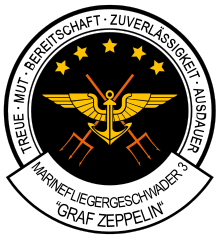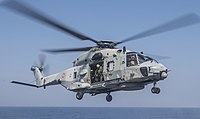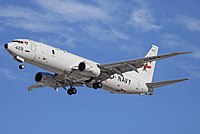Marineflieger
| Naval Aviation Command | |
|---|---|
| Marinefliegerkommando | |
 Insignia of the Marinefliegerkommando | |
| Founded | 1956 |
| Country | |
| Branch | German Navy |
| Type | Naval aviation |
| Size | 2,500 personnel 57 aircraft |
| Part of | German Navy |
| Garrison/HQ | Nordholz Naval Airbase |
| Website | [1] |
| Commanders | |
| Kommandeur des Marinefliegerkommandos | Kapitän zur See Thorsten Bobzin |
| Insignia | |
| Roundel |  |
| Fin flash | |
| Aircraft flown | |
| Attack | Sea Lynx Mk 88 A P-3C Orion |
| Patrol | Sea King Mk 41 Sea Lynx Mk 88 A P-3C Orion |
| Reconnaissance | P-3C Orion Dornier 228 LM |
| Trainer | H135 |
| Transport | Sea King Mk 41 Sea Lynx Mk 88 A |
The Marinefliegerkommando (Naval Aviation Command) is the naval air arm of the German Navy. It is aircraft flown by the Navy of Germany, and mostly consists of helicopters and fixed-wing maritime patrol aircraft, as well as types of drones. Naval helicopters can operate from ships, and some of their roles include utility and supply tasks, search and rescue, and ASW or naval warfare. The fixed-wing aircraft operate from land bases but will patrol over open water. The Navy also operates training aircraft and unmanned drones. Naval aviation is subordinate to the German Navy, separate from the German Air Force.
History
[edit]During the First World War, naval aviators were part of the Kaiserliche Marine. After the war Germany was no longer allowed to maintain a military aviation capability. Heer and Marine both attempted to nevertheless maintain theoretical and practical knowledge of air warfare through concealed activities such as pilot training efforts.[1] After the National Socialists had risen to power, these activities intensified until Nazi Germany unilaterally declared its withdrawal from armament limitations in 1935. The nascent rump naval air arm was quickly absorbed by Hermann Göring's newly established Luftwaffe.
However, as a component of the air force, the Seeflieger maintained their organisational structure.[2] A carrier-based aviation component was planned for the aircraft carrier Graf Zeppelin, laid down in 1936, but lack of suitable aircraft, coupled with the reluctance of the Luftwaffe to support the Kriegsmarine in the carrier's construction, culminated in its eventual cancellation in 1943.
After the Second World War, it was not until West Germany's entry into NATO in the 1950s and the establishment of the Bundesmarine, that a naval aviation force (Marineflieger) was formed.
The United Kingdom was instrumental in the creation of the Marineflieger, supplying training and aircraft. A number of Royal Navy Fleet Air Arm (FAA) officers operated as part of the German Navy in the process. The first aircraft included Hawker Sea Hawks, which were used by Marinefliegergeschwader 1 and 2, and Fairey Gannets. Until the new bases were ready, pilots were trained with the FAA in the UK.
The first Kommando der Marineflieger was created in July 1956 in Kiel-Holtenau and elevated to divisional level in 1964, renamed to Marinefliegerkommando in 1967 and to Marinefliegerdivision in 1969 as it grew in size. This Naval Aviation Division commanded five wings and several supporting units in total before 1990, including two combat aircraft wings equipped with Lockheed Starfighter fighter aircraft and then the Panavia Tornado. The Fairey Gannet maritime patrol aircraft (MPA) was replaced with the Bréguet Atlantic.
After the Cold War, the unit was renamed to Flotille der Marineflieger in 1994 and reduced to a brigade-level command. Its last combat aircraft were handed over to the German Air Force in 2005 before the flotilla was dissolved on 30 June 2006. Afterwards, the remaining wings were directly assigned to fleet command until 8 October 2012, when the current Marinefliegerkommando was created in Nordholz under Kapitän zur See Andreas Horstmann, who had already been charged with naval aviation at fleet command in Rostock from 2006 to 2009.[3] At the same time the remaining naval aviation aircraft were largely consolidated at Nordholz Naval Airbase.
Subordinate units
[edit]Apart from the staff, two - the 3rd and 5th - wings are currently assigned to the unit.
Naval Air Wing 3 (MFG 3) "Graf Zeppelin"
[edit]
The German Navy's fixed-wing aircraft, namely eight Lockheed P-3C Orion MPA taken over from the Dutch Navy and two modified Dornier 228LM pollution control aircraft are assigned to the 3rd wing, Marinefliegergeschwader 3 "Graf Zeppelin". The unit is also responsible for handling flight operations in Nordholz. It was established in 1964.
The wings tasks include surveillance and control of large sea areas as well as maritime warfare against targets above (ASuW) and below water (ASW).[4] Pollution control patrols are carried out implementing the MARPOL 73/78 convention on behalf of and in cooperation with German civilian authorities, namely the German coastal states and agencies under the Federal Ministry of Transport, who do not maintain the appropriate aircraft themselves.
The P-3Cs are to be replaced with eight P-8 Poseidon MPAs from 2024 on[5] in order to avoid a looming capability gap caused by bringing forward the out-of-service date of the P-3Cs to 2025. A prior attempt to extensively refurbish the aircraft and extend their service time to 2035 was abandoned due to cost and technical issues.[6]
A technical support group (Gruppe) and a flying group, each with two flights (Staffeln) make up the unit along with an airbase group which is responsible for logistics, command infrastructure and air traffic:[7]
- Staff
- Flying Group
- 1st Flight (P-3C)
- 2nd Flight (P-3C, Do-228LM)
- Technical Group
- Technical Flight (P-3C)
- Technical Flight (general purpose)
- Air Base Group
- Flying Group
Naval Air Wing 5 (MFG 5)
[edit]
Marinefliegergeschwader 5 commands the navies rotorcraft fleet of Westland Sea Lynx MK 88 A and Sea King Mk 41 helicopters, tasked with ship-based anti-submarine warfare, anti-surface warfare, transport and special forces support duties and is responsible for search and rescue (SAR) duty in the North and Baltic seas. The Sea King fleet is currently transitioning to the NH90 Sea Lion.[citation needed] Sea Lion operations began during June 2020 and the wing will eventually have 20 in service.[8] The NH90 in its Sea Tiger version will also replace the Sea Lynx from 2025 on as the navies frigate-based helicopter.[9]
The unit redeployed in 2012-2013 to Nordholz from Kiel-Holtenau where it had been stationed since its creation in 1958.
- Staff
- Flying Group
- 1st Flight (Sea Lynx Mk 88 A)
- 2nd Flight (Sea King Mk 41)
- ? Flight (Sea Lion)
- Instruction Flight
- Technical Group
- Technical Flight (Sea Lynx Mk 88 A)
- Technical Flight (Sea King Mk 41)
- Technical Flight (Sea Lion)
- Technical Instruction Flight
- Flying Group
Aircraft
[edit]The command had 2,500 personnel on active duty in 2020.[10] As of 2019, it operates 54 aircraft.[11]
Current fleet
[edit]| Model | Image | Origin | Role | Ordered | Introduced | Operational | Notes |
|---|---|---|---|---|---|---|---|
| Rotorcraft | |||||||
| Westland Sea Lynx Mk 88 A | 
|
Anti-submarine warfare, | 26 | 1981 | 24[12] | To be replaced by the NH90 NFH Sea Tiger from 2025 to 2030.
Equipment:[13]
| |
| NH90 NTH
"Sea Lion" |

|
Multi-role helicopter
Vertical replenishment) |
18 | 2018 | 18 | [14][15] | |
| Airplane | |||||||
| Lockheed
"P-3C CUP+" |

|
Maritime patrol aircraft | 8 | 2006 | 2[16] | 8 P-3 Orion purchased to the Netherlands replacing Bréguet 1150 Atlantic.[17]
Will be replaced by Boeing P-8 Poseidon 6 P-3 Orion sold to Portugal, final 2 to be delivered in 2025.[18] | |
| Dornier 228 LM | 
|
Pollution control | 2 | 1991 | 2[19] | [20] | |
| UAV | |||||||
| DJI Phantom IV | 
|
ISR
Intelligence, surveillance, and reconnaissance |
5 | 2017 | 5 | Commercial UAV | |
| Aerovironment RQ-20B Puma AE II
"LARUS" |

|
ISR
Intelligence, surveillance, and reconnaissance |
6 | 2019 | 6 | 3 systems with 2 drones each ordered in 2018 [22] | |
| Saab Skeldar V-200
"Sea Falcon" |

|
ISR
Intelligence, surveillance, and reconnaissance |
2 | 2020 | 2 | Ordered in 2017 as part of an urgent research programme VorMUAS to equip the K130 Braunschweig class[23]
8 additional Sea Falcon are eventually planned. | |
Future fleet
[edit]| Model | Image | Origin | Type | Role | Ordered | Introduction | Notes |
|---|---|---|---|---|---|---|---|
| NH90 NFH
"Sea Tiger" |

|
Rotorcraft | Multi-role helicopter
(Anti-submarine warfare, anti-surface warfare, reconnaissance and transport) |
31 | 2025 | Ordered in 2020, to be delivered from 2025 to 2030. Qualifications trials started in 2023.[24][25]
The equipment for the helicopter is:
The armament will be:
| |
| Boeing P-8A Poseidon | 
|
Fixed wing aircraft | Maritime patrol aircraft | 8 | 2025 | Selected to replace the P-3C Orion in 2021:[26]
Delivery of first in 2024, 8 to be introduced in service in 2025 |
Contractors
[edit]| Model | Image | Origin | Type | Role | Ordered | Introduction | Notes |
|---|---|---|---|---|---|---|---|
| AW139 | 
|
Multi-role helicopter | Training rotorcraft | — | 2025 | HeliOperations will train the German Navy helicopter pilots for 7 years in Dorset (UK).[27] |
Former fleet
[edit]The Marineflieger previously operated the following aircraft:
- Panavia Tornado
- F-104 G Starfighter
- Hawker Sea Hawk
- Fairey Gannet
- Breguet Atlantic
- Dornier Do 28
- Westland Sea King Mk.41
Gallery
[edit]-
A Tornado IDS at RAF Mildenhall in 1984
-
A Lynx helicopter on the flight deck of a German frigate in 1993
-
A P-3 Orion painted with a special scheme for the 100th anniversary of the Marineflieger
-
A Westland Sea King in 2013
-
A Dornier 228 in 2013
See also
[edit]References
[edit]- ^ Paterson, Lawrence (2019). Eagles Over the Sea: Luftwaffe Maritime Operations 1935–1942. Great Britain: Seaforth Publishing. pp. 15–18. ISBN 978-1-5267-4002-1.
- ^ "100 Years of German Naval Aviation". Joint Air Power Competence Centre. 2014-09-14. Retrieved 2021-10-29.
- ^ "Startschuss für das Marinefliegerkommando in Nordholz". presseportal.de (in German). 4 October 2012. Retrieved 2021-10-29.
- ^ "Naval Aviation Command". www.bundeswehr.de. Retrieved 2021-10-29.
- ^ ES&T editorial team (29 September 2021). "P-8A Poseidon ordered from Boeing for the German Navy". esut.de. Retrieved 2021-10-29.
- ^ Manaranche, Martin (2020-06-17). "German MoD Ends P-3C Orion MPA Modernization Program - Seeking Alternative". Naval News. Retrieved 2021-10-29.
- ^ Seedorf, Mark. "Standortbroschüre Cuxhaven/Nordholz" (PDF). Archived (PDF) from the original on 6 April 2015.
- ^ AirForces Monthly. Stamford, Lincolnshire, England: Key Publishing Ltd. August 2022. p. 18.
- ^ Donald, David. "Germany Orders NH90 Sea Tiger Helicopters". Aviation International News. Retrieved 2021-10-29.
- ^ "Marineflieger im Umbruch" (in German). 25 October 2023.
- ^ "World Air Forces 2019". Flightglobal: 16. Retrieved 7 August 2019.
- ^ ES&T Redaktion (2020-11-24). "Marine erhält 31 Sea Tiger als Ablösung für 24 Sea Lynx". esut.de (in German). Retrieved 2024-03-22.
- ^ "Bordhubschrauber Sea Lynx Mk88A". www.bundeswehr.de (in German). Retrieved 2024-03-22.
- ^ "NH-90 NTH Sea Lion". www.bundeswehr.de (in German). Retrieved 2024-03-22.
- ^ Cuenca, Oliver. "German Navy receives last Sea Lion". AirMed&Rescue. Retrieved 2024-03-22.
- ^ "Joker zieht nicht mehr: Kein Seefernaufklärer der Marine einsatzbereit – Augen geradeaus!". augengeradeaus.net. Retrieved 2024-03-22.
- ^ "P-3C Orion German Navy Deutsche Marine MPA". www.seaforces.org. Retrieved 2024-03-22.
- ^ "Portugal to buy German Orion MPAs". Janes.com. Retrieved 2024-03-22.
- ^ Page 19 of the pdf: https://www.flightglobal.com/download?ac=75345
- ^ "Die Flugzeugflotte der Bundesmarine - Dornier Do 228-212 | FLUG REVUE". www.flugrevue.de. Archived from the original on 2017-06-08.
- ^ http://dipbt.bundestag.de/doc/btd/19/010/1901082.pdf [bare URL PDF]
- ^ "Puma AE für die Marine - FLUG REVUE". www.flugrevue.de. Archived from the original on 2020-09-22.
- ^ "Skeldar V-200 Archives - bundeswehr-journal". Retrieved 2024-03-22.
- ^ "German Navy NH90 Sea Tiger performs maiden flight". www.airbus.com. Retrieved 2024-03-22.
- ^ "Maiden Flight of German Navy NH90 Sea Tiger". Joint Forces News. 2023-12-05. Retrieved 2024-03-22.
- ^ Luck, Alex (2023-11-18). "Germany buying more Poseidon, question marks on MAWS". Naval News. Retrieved 2024-03-22.
- ^ "HeliOperations Contract to Train German Naval Helicopter Pilots". Joint Forces News. 2024-11-08. Retrieved 2024-11-09.





